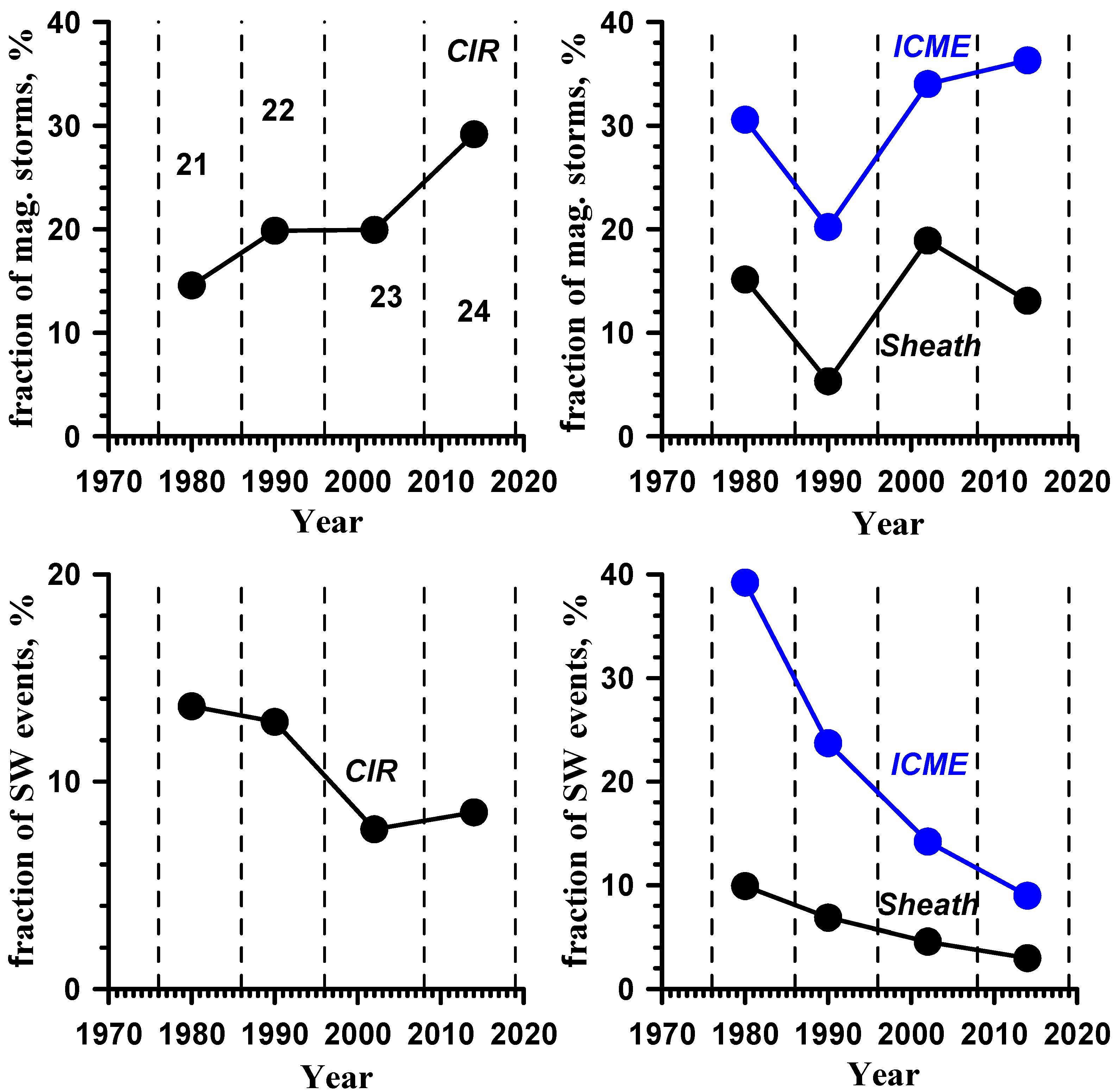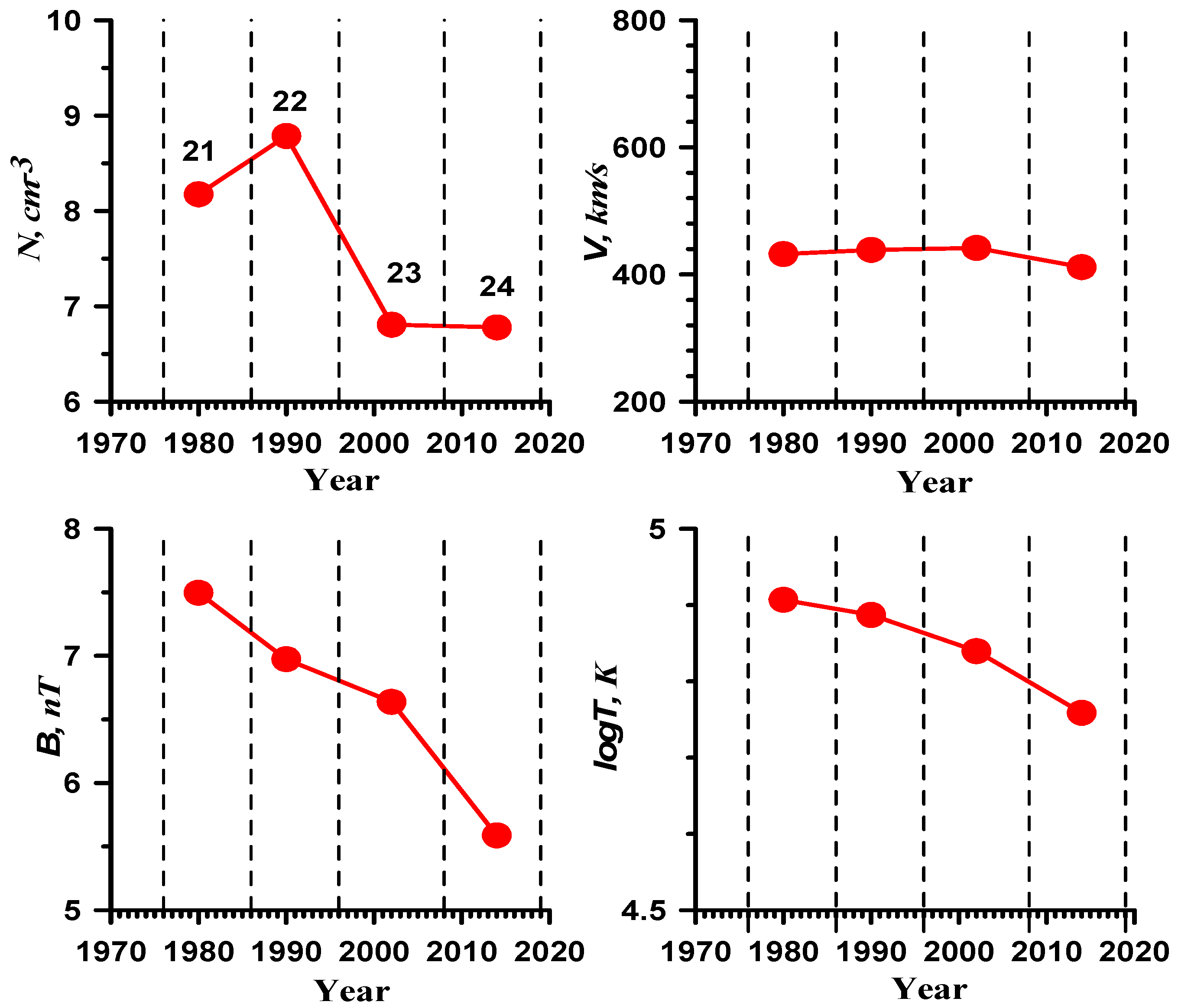Peculiarities of the Heliospheric State and the Solar-Wind/Magnetosphere Coupling in the Era of Weakened Solar Activity
Abstract
:1. Introduction
2. Data and Methods
3. Results and Discussion
- (1)
- Because during SCs 23–24, the temperature and IMF value dropped at a constant velocity, the sonic and Alfvén Mach numbers in the solar wind increased, i.e., in the present epoch, the magnetosphere is flowed around by more “supersonic” and more “super-alfvenic” SW than in the previous SCs 21–22. In addition, the drop in the beta parameter (not shown here but presented in [10]) indicates that the drop in magnetic pressure was less than the drop in thermal pressure. Therefore, the regime of the SW flow around the magnetosphere of the Earth and their interaction may differ from that during the previous period.
- (2)
- Because the density and dynamic pressure dropped by ~30% during SCs 23–24, the pressure balance of the interplanetary plasma and the magnetospheric plasma at the magnetopause was located further from the center of the Earth, i.e., the size of the magnetosphere and its structures has increased, and the pressure inside the magnetosphere decreased. This can affect both the nature of SW interaction with the magnetosphere and the physical processes within the magnetosphere [8,15,16].
- (3)
- For the epoch of high solar activity, it was shown that the efficiency of excitation of magnetic storms is higher for sheath and CIR events than for ICMEs [3,13]. The relative number of disturbed SW streams, especially those associated with CME, dropped significantly during the epoch of low solar activity. In [10,14], we noted a drop in the main parameters of plasma and IMF in all types of SW, and in the disturbed types, the reduction in parameters was greater than in the undisturbed types. Differences in the reduction in different parameters in different interplanetary drivers can affect the efficiency of different types of SW.
4. Conclusions
Author Contributions
Funding
Acknowledgments
Conflicts of Interest
References
- Gonzalez, W.D.; Tsurutani, B.T.; Clua de Gonzalez, A.L. Interplanetary origin of geomagnetic storms. Space Sci. Rev. 1999, 88, 529–562. [Google Scholar] [CrossRef]
- Yermolaev, Y.I.; Yermolaev, M.Y.; Zastenker, G.N.; Zelenyi, L.M.; Petrukovich, A.A.; Sauvaud, J.A. Statistical studies of geomagnetic storm dependencies on solar and interplanetary events: A review. Planet. Space Sci. 2005, 53, 189–196. [Google Scholar] [CrossRef]
- Yermolaev, Y.I.; Lodkina, I.G.; Dremukhina, L.A.; Yermolaev, M.Y.; Khokhlachev, A.A. What solar–terrestrial link researchers should know about interplanetary drivers. Universe 2021, 7, 138. [Google Scholar] [CrossRef]
- Borovsky, J.E.; Denton, M.H. Differences between CME-driven storms and CIR-driven storms. J. Geophys. Res. 2006, 111, A07S08. [Google Scholar] [CrossRef]
- Kilpua, E.K.J.; Fontaine, D.; Moissard, C.; Ala-Lahti, M.; Palmerio, E.; Yordanova, E.; Turc, L. Solar wind properties and geospace impact of coronal mass ejection-driven sheath regions: Variation and driver dependence. Space Weather. 2019, 17, 1257–1280. [Google Scholar] [CrossRef]
- Feynman, J.; Ruzmaikin, A. The Sun’s strange behavior: Maunder minimum or Gleissberg cycle? Sol. Phys. 2011, 272, 351–363. [Google Scholar] [CrossRef]
- Zolotova, N.V.; Ponyavin, D.I. Is the new Grand minimum in progress? J. Geophys. Res. Space Phys. 2014, 119, 3281–3285. [Google Scholar] [CrossRef]
- Oh, S.; Kim, B. Variation of solar, interplanetary and geomagnetic parameters during solar cycles 21-24. J. Astron. Space Sci. 2013, 30, 101–106. [Google Scholar] [CrossRef]
- Gopalswamy, N.; Yashiro, S.; Xie, H.; Akiyama, S.; Makela, P. Properties and geoeffectiveness of magnetic clouds during solar cycles 23 and 24. J. Geophys. Res. Space Phys. 2015, 120, 9221–9245. [Google Scholar] [CrossRef]
- Yermolaev, Y.I.; Lodkina, I.G.; Khokhlachev, A.A.; Yermolaev, M.Y.; Riazantseva, M.O.; Rakhmanova, L.S.; Moskaleva, A.V. Drop of solar wind at the end of the 20th century. J. Geophys. Res. Space Phys. 2021, 126, e2021JA029618. [Google Scholar] [CrossRef]
- King, J.H.; Papitashvili, N.E. Solar wind spatial scales in and comparisons of hourly wind and ACE plasma and magnetic field data. J. Geophys. Res. 2005, 110, A02209. [Google Scholar] [CrossRef]
- Yermolaev Yu, I.; Nikolaeva, N.S.; Lodkina, I.G.; Yermolaev, M.Y. Catalog of Large-Scale Solar Wind Phenomena during 1976-2000. Cosm. Res. 2009, 47, 81–94. [Google Scholar] [CrossRef]
- Yermolaev, Y.I.; Nikolaeva, N.S.; Lodkina, I.G.; Yermolaev, M.Y. Geoeffectiveness and efficiency of CIR, sheath, and ICME in generation of magnetic storms. J. Geophys. Res. 2012, 117, A00L07. [Google Scholar] [CrossRef]
- Yermolaev, Y.I.; Lodkina, I.G.; Khokhlachev, A.A.; Yermolaev, M.Y.; Riazantseva, M.O.; Rakhmanova, L.S.; Borodkova, N.L.; Sapunova, O.V.; Moskaleva, A.V. Dynamics of Large-Scale Solar-Wind Streams Obtained by the Double Superposed Epoch Analysis: 5. Influence of the Solar Activity Decrease. Universe 2022, 8, 472. [Google Scholar] [CrossRef]
- Antonova, E.E.; Kirpichev, I.P.; Stepanova, M.V. Plasma pressure distribution in the surrounding the Earth plasma ring and its role in the magnetospheric dynamics. J. Atmos. Sol. Terr. Phys. 2014, 115, 32. [Google Scholar] [CrossRef]
- Kirpichev, I.P.; Antonova, E.E.; Stepanova, M. Ion leakage at dayside magnetopause in case of high and low magnetic shears. J. Geophys. Res. Space Phys. 2017, 122, 8078–8095. [Google Scholar] [CrossRef]



Publisher’s Note: MDPI stays neutral with regard to jurisdictional claims in published maps and institutional affiliations. |
© 2022 by the authors. Licensee MDPI, Basel, Switzerland. This article is an open access article distributed under the terms and conditions of the Creative Commons Attribution (CC BY) license (https://creativecommons.org/licenses/by/4.0/).
Share and Cite
Yermolaev, Y.I.; Lodkina, I.G.; Khokhlachev, A.A.; Yermolaev, M.Y. Peculiarities of the Heliospheric State and the Solar-Wind/Magnetosphere Coupling in the Era of Weakened Solar Activity. Universe 2022, 8, 495. https://doi.org/10.3390/universe8100495
Yermolaev YI, Lodkina IG, Khokhlachev AA, Yermolaev MY. Peculiarities of the Heliospheric State and the Solar-Wind/Magnetosphere Coupling in the Era of Weakened Solar Activity. Universe. 2022; 8(10):495. https://doi.org/10.3390/universe8100495
Chicago/Turabian StyleYermolaev, Yuri I., Irina G. Lodkina, Alexander A. Khokhlachev, and Michael Yu. Yermolaev. 2022. "Peculiarities of the Heliospheric State and the Solar-Wind/Magnetosphere Coupling in the Era of Weakened Solar Activity" Universe 8, no. 10: 495. https://doi.org/10.3390/universe8100495
APA StyleYermolaev, Y. I., Lodkina, I. G., Khokhlachev, A. A., & Yermolaev, M. Y. (2022). Peculiarities of the Heliospheric State and the Solar-Wind/Magnetosphere Coupling in the Era of Weakened Solar Activity. Universe, 8(10), 495. https://doi.org/10.3390/universe8100495






